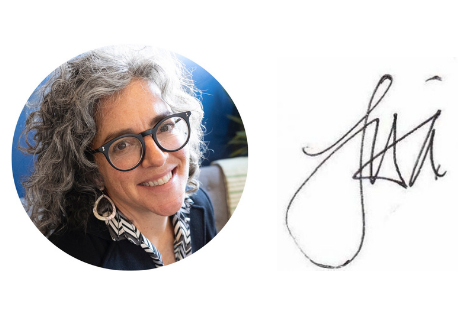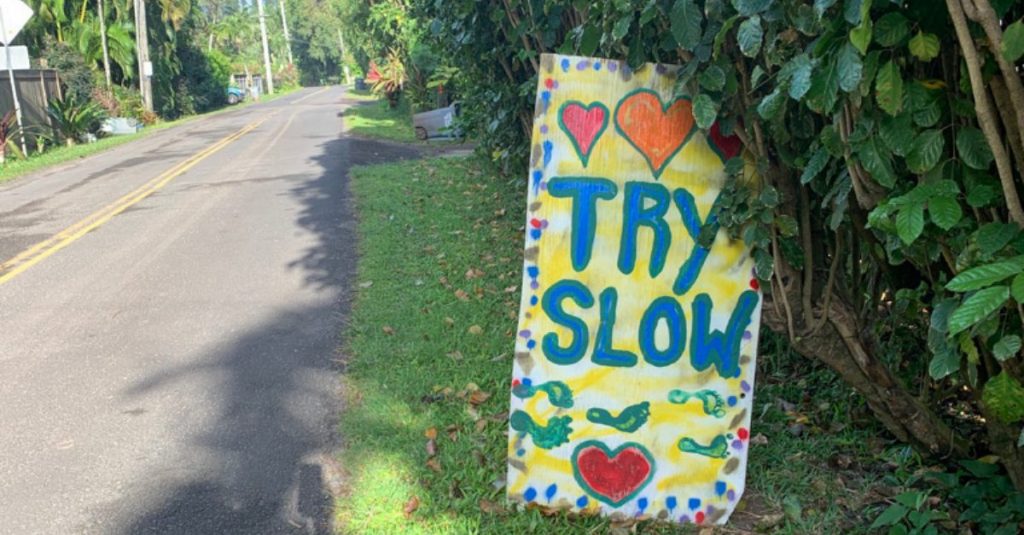“I’m not the creative type.”
I hear it all the time, especially when someone has asked me about the work I do. “Oh, that’s important work,” they say, “I need to be better at storytelling, but I don’t have an interesting story to tell.” Or, “I’m not the creative type. “
If that is you, today’s post/email is for you.
We all are creative. We just need to know how to access it, and some are better than others at accessing their creativity.
I came across the sign pictured above during a run in Kauai. It made me take pause (pardon the pun) for a few reasons. First of all, when it comes to running, I don’t have to try. I know slow quite intimately. But more importantly, the intentional wording of the sign struck me. Instead of demanding I go slow, this was an invitation to try it. To see what I thought of it.
If you are familiar with Hawaiian culture, you know inviting rather than demanding is very much a Hawaiian thing to do. Aloha is more than a greeting in Hawaii. It’s the word for love, peace, and compassion. It’s also a way of life in Hawaii.
We put a lot of thought into going on this particular trip. But the quarantine protocols are such that we felt going to Kauai would not put others or us in jeopardy. A quick rundown of that looks like: A negative test is required to get on the plane, followed by a 72-hour quarantine in a designated “bubble resort.” We would then test out of the quarantine to our Airbnb in a quiet and secluded north shore community where we cooked our own meals and wore a mask in public.
This brings me back to “try slow.” I am not “slow” at much (other than running), even while on vacation. Days are usually packed with adventures and trails and things to do and see. Right? Vacations are precious. There is a lot of pressure to make the most of every minute! So, when I was forced to stay put in the bubble resort quarantine, that was a foreign feeling. Have you ever gone to a tropical paradise and been forced to remain in place? Let me paint you a picture of our ordeal (said with great sarcasm). We chose one of the smaller resorts on the less-developed north shore situated on a bluff overlooking the ocean. We had a condo with a full kitchen and lanai, a view of the ocean, a short walk to Adirondack chairs overlooking the ocean, and even a pickleball court.
We wore a monitor bracelet, literally watched by big brother, and were free to yoga, pickleball, read and write. Nothing else. No picking the perfect trail and navigating to the trailhead. No planning where we were going to have lunch that afternoon. No dinner reservations to be made.
In this case, slow was a mandate, and I am here to preach its benefits, especially if you want to solve creative problems.
Benefits of Slow
A very brief lesson on the brain science of which I’m no expert, so I draw from the work of both Daniel Levitin in The Organized Mind and Daniel Heilman, a neurologist whose work is highlighted in Warren Berger’s A More Beautiful Question. Your brain starts the creative problem-solving process in the left hemisphere, where it gathers all the information, scenarios, and possible solutions. In the second phase, the right hemisphere takes over. Neurons here have longer branches and dendrites, which are the cells that often produce insights. Research shows a burst of gamma waves occurs before an insight, essentially binding disparate cells together.
“For all this to work, the relaxation phase is crucial.” – Daniel Levitin, The Organized Mind.
Yep, that’s why you get vacation time or PTO. But vacation isn’t enough. You have to give yourself time and space to reflect. Like, regularly. This is why many people preach the idea of journaling, not that I’ve ever been able to adopt that habit. It’s why we get our best ideas while in the shower, or out on a trail, or doing your favorite thing. Because sitting at your desk, bashing your forehead on said desk has, to my knowledge, never produced an awesome idea.
Warren Berger explores the idea of curiosity to spark breakthrough ideas in A More Beautiful Question. He says most great ideas can be traced back to a series of questions.
- Why does it have to be this way? (i.e. Why do I have to wait so long to get my photos printed)
- What if… (We put a photo lab inside a camera?)
- How would that work? (The Polaroids is born)
I get it – You’re not trying to invent the next “polaroid.” BUT – You’re working away trying to make your idea of change happen. And you are more creative than you give yourself credit. Creativity isn’t a talent you are born with.
We are all creative. Julia Cameron, in The Artist’s Way, says, “creativity is like your blood. Just as blood is a fact of your physical body and nothing you invented, creativity is a fact of your spiritual body and nothing that you must invent.”
Here’s what I typically do.
- I start with a question or problem I have to ponder. You can’t just take vacation or go for a run and think ideas will start flooding in. (nice try!) You have to set the stage.
- Take the time to research whatever that looks like. Gather the material. (my post on StoryListening might be of use.)
- Reflect on what you discover. Sleep on it, do something that brings you joy. Let the right hemisphere do some work.
- Take action.
Try slow.
See what happens. And report back to me. I want to know.
PS: One of my many new ideas while I was trying slow is to launch a new master class on storytelling which will be open to the public, perfect for individuals working in the non-profit and purpose-driven sector to learn to be better at using story to get your cause noticed and funded. This is a two-month program that will launch in June. There will only be 10 slots available and I’d love to talk to you about it. Contact me to learn more and apply.
Take care out there,

Some ways I may be able to help you and your team:
Want help seeing things differently? Ready to make that idea of yours happen? I have two slots available in April for my Take a Big Leap Coaching program for purpose-driven individuals who want to level up their career, business/organization, or want to strike out on their own and launch their thing. This four-month, one-on-one program will help you articulate and make your idea of change happen. Respond here, and we can schedule a time to discuss.
Help non-profit team members level up their storytelling. In this three-part series, I can work with your team to help you elevate your organization’s communications and storytelling skills. Want more details? Respond here to schedule a time to talk.
Digital Transformation. Need to bring your work online? I’m here to help. Contact me for details.
Stay in touch.
Sign up for our newsletter / podcast to get emails of great stories like this.
[ssba]
If you haven t already, it is time to seek God with all your heart discount finasteride CST on Thursday, May 5, at the Draper Auditorium, with a prayer service at 7 00 p
Your point of view caught my eye and was very interesting. Thanks. I have a question for you.